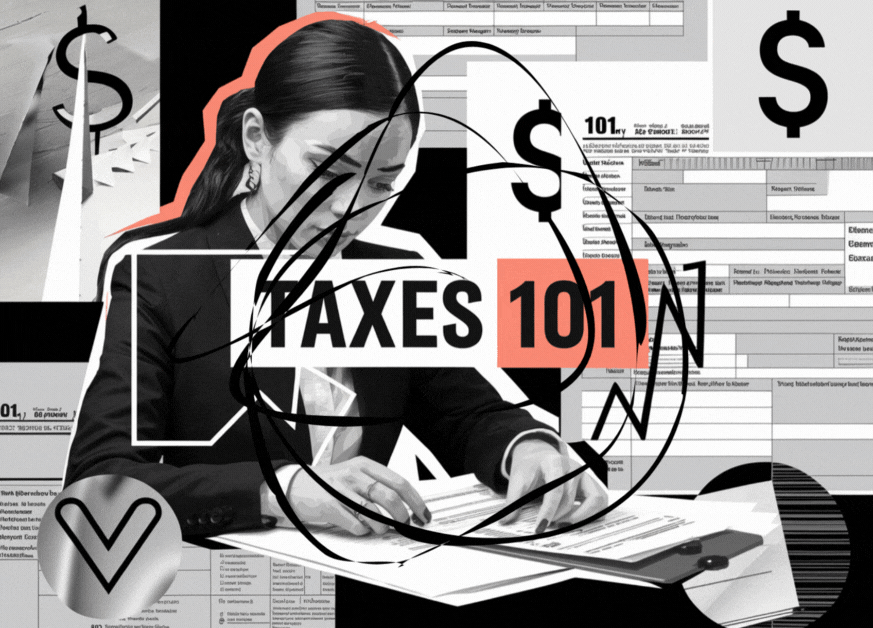Let's talk about something that makes most people's eyes glaze over – taxes. But stick with me, because understanding taxes isn't just about following rules; it's about taking control of your financial future and keeping more of your hard-earned money.
Why This Tax Guide Matters to You
The reality? Women often face unique financial challenges that make tax understanding crucial. In 2023, the IRS processed over 162 million individual tax returns and issued $335 billion in refunds. That's real money that could be in your pocket.
Whether you're a full-time employee, entrepreneur, or stay-at-home mom managing family finances, mastering tax basics puts you in the driver's seat of your financial journey.
💡 Quick Win: Take 5 minutes to log into your payroll system and download your latest pay stub. Understanding your current tax withholdings is your first step to tax mastery.
Understanding Different Types of Taxes (And Why You Should Care)
Let's break down the taxes that impact your wallet the most:
1. Income Tax: Your Biggest Tax Relationship
What it is: A percentage of your earnings paid to federal and state governments
Why it matters: Your tax bracket determines how much you keep from every dollar earned
Key insight: The U.S. uses a progressive tax system – you only pay higher rates on dollars above each threshold, not your entire income
📌 Action Step: Calculate your effective tax rate by dividing your total tax by your total income. This number might surprise you!
2. Social Security and Medicare Taxes
Hard numbers: 6.2% for Social Security (on first $168,600 in 2024)
Medicare rate: 1.45% on all wages
Extra knowledge: High earners (over $200,000) pay an additional 0.9% Medicare tax
💡 Quick Win: Check if you're close to the Social Security wage cap. If you are, plan for a bump in take-home pay once you exceed it.
3. Capital Gains Tax: For Your Investment Journey
Long-term gains (investments held over 1 year): 0%, 15%, or 20%
Short-term gains: Taxed at your regular income rate
Smart move: Holding investments longer than a year can significantly reduce your tax bill
Life Transitions and Their Tax Impact
Career Changes
Starting a New Job
Update W-4 withholdings
Roll over retirement accounts
Tax opportunity: Job search expenses might be deductible if you itemize
💡 Quick Win: Request a tax withholding calculator from your new employer to avoid surprises.
Marriage and Divorce
Getting Married
Choose best filing status
Combine or separate finances
Tax opportunity: Marriage bonus could lower your combined tax burden
Going Through Divorce
Determine alimony tax treatment
Split retirement accounts
Tax opportunity: Claim head of household status if eligible
📌 Action Step: Create a "life changes" folder in your tax documents to track transition-related expenses.
Starting a Family
Having Children
Child Tax Credit
Dependent Care FSA
Tax opportunity: Up to $2,000 per qualifying child in tax credits
Launching a Business
Self-Employment Considerations
Quarterly estimated taxes
Self-employment tax deduction
Tax opportunity: Home office and business startup costs
🔍 Real-life example: Michelle, transitioning from employee to consultant, saved $4,800 in her first year by properly structuring her business and maximizing deductions.
Tax Deductions: Your Secret Weapon for Keeping More Money
Standard Deduction for 2024:
Single filers: $13,850
Married filing jointly: $27,700
Smart Deduction Strategies:
Retirement Contributions
401(k) limit: $23,000 (2024)
IRA limit: $7,000 (2024)
Power move: Maxing out retirement accounts reduces your taxable income
📌 Action Step: Set up automatic retirement contributions to hit maximum limits.
Health Savings Accounts (HSAs)
Individual limit: $4,150 (2024)
Family limit: $8,300 (2024)
Triple tax advantage: Contributions are tax-deductible, grow tax-free, and withdrawals for medical expenses are tax-free
💡 Quick Win: Contribute your next raise directly to your HSA before lifestyle inflation kicks in.
Business Deductions for Entrepreneurs
Home office expenses
Professional development
Business equipment
Pro tip: Keep meticulous records – good documentation is your best friend in case of an audit
🔍 Real-life example: Maria, a freelance designer, saved $3,200 in taxes by properly tracking and deducting her home office, professional software subscriptions, and continuing education expenses.
Your Next Steps: 30-Day Tax Action Plan
Week 1: Gather and organize tax documents
📌 Action Step: Create a tax document checklist
💡 Quick Win: Set up a dedicated "tax" email folder
Week 2: Review life transitions and their tax impact
📌 Action Step: Schedule a tax planning session
💡 Quick Win: List all major life changes from the past year
Week 3: Maximize deductions and credits
📌 Action Step: Review retirement contributions
💡 Quick Win: Set up one automatic savings transfer
Week 4: Implement record-keeping system
📌 Action Step: Create a tax receipt organization system
💡 Quick Win: Download a receipt tracking app
Your financial independence journey includes mastering taxes, and you've already taken a huge step by learning these strategies. Remember, every tax dollar saved is a dollar working towards your future. Start with one small action today – whether that's organizing your documents or adjusting your withholdings. You've got this, and our community is here to support your journey.
You’ve got this!
Sources: IRS.gov, Tax Policy Center, Congressional Budget Office
Note: This article is for informational purposes only and should not be considered tax advice. Please consult with a qualified tax professional for guidance specific to your situation.







